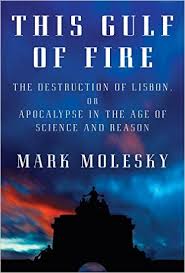This Gulf of Fire: The Destruction of Lisbon, or Apocalypse in the Age of Science and Reason
- By Mark Molesky
- Alfred A. Knopf
- 512 pp.
- Reviewed by R.W. Clark
- December 18, 2015
How a great earthquake laid waste to a city and challenged the very notion of God.

Lisbon was once an ostentatiously wealthy city and the hub of a worldwide trading empire. Then — quite suddenly — nature rose up and destroyed it. On the morning of November 1, 1755, the most powerful earthquake ever recorded in Europe triggered a tsunami and firestorm that flattened palaces and cathedrals, sank ships, incinerated gold and treasure, and killed up to 50,000 people. Stunned and disbelieving, Europeans everywhere began to ask, “Why?”
This Gulf of Fire is the definitive history of the Lisbon earthquake and its aftermath. It combines exhaustive research with dramatic eyewitness accounts and modern discoveries in geology and seismology. The writing is colorful, and although the story is detailed, it is kept to a manageable 360 pages through footnoting.
Author Mark Molesky describes the 18th-century city on the Tagus River as an exotic Babylon. Wealth flowed into it from colonies on three continents, a legacy of the great Portuguese explorers and conquerors who sailed the world in the 16th century.
Dom José I, the all-powerful king, funded libraries, culture, and public works. But he also gave cups filled with jewels to aristocratic friends who lived in opulent baroque palaces built in a dazzling mixture of styles — Asian and European, African and Iberian, Moorish and Christian. Meanwhile, in the cramped streets of the medieval Baixa, or downtown, 10 percent of the people remained homeless.
Churches and monasteries dotted the landscape, one-sixth of the people were clergy, and the Inquisition reigned supreme. Yet prostitution and venereal disease ran rampant, too, and “the distinction between convents and brothels was practically nonexistent.” The pious condemned Lisbon for its hypocrisy and later viewed the quake as the vengeful act of an outraged God.
We now know that the Great Lisbon Earthquake began off the coast of southern Portugal, along the fault line that separates the continental plates of Africa and Eurasia. The author reports that the tremor and resulting tsunami devastated northwest Africa (modern-day Morocco) and western and southern Iberia, and was felt throughout the North Atlantic. The tsunami spared the United States, but the Cape Ann Earthquake of November 18, 1755, which shook the East Coast, may have been an aftershock from Lisbon.
How bad was it? It was cataclysmic, a thousand times more powerful than the Haiti quake in 2010. Tragically, it struck during morning mass on All Saints’ Day, turning Lisbon’s crowded churches into death traps. Molesky is not a sensationalist, but eyewitnesses describe “imploding buildings, heart-stopping noises, spreading fires, clouds of dust and smoke, and the pitiful wails of men and beasts.” Survivors fled to the seashore, only to be drowned in the tsunami or forced back into the fires that engulfed the ruined city. Anarchy reigned, family members abandoned one another, the strong preyed on the weak, and Judgment Day seemed to be at hand.
Without CNN, news of the disaster did not reach Paris and London for weeks, and relief shipments didn’t arrive for months. London, Madrid, and Hamburg sent food, money, and timber; the Vatican sent prayers. But no group did more to ease the suffering of Lisboans than its clergy, who rescued survivors, dispensed food, treated wounds, and comforted the dying.
Amid the chaos, a strongman arose who would dominate Portugal for almost two decades. Sebastião de Melo, later the Marquis de Pombal, was the King’s war secretary and quickly became his First Minister and effective dictator. He instituted what Molesky calls a “reign of terror” that restored order, rebuilt Lisbon, and tamed the nobles and church. Visitors to Lisbon today can observe his handiwork in the Baixa, where a modern urban center has replaced the medieval old town.
In describing the rebuilding of Lisbon, Molesky introduces the debate between reason and faith that the quake provoked. Pombal advocated the Enlightenment view that earthquakes were random acts of nature, not God. The Jesuits, a powerful religious order, protested, and proclaimed that Lisbon was living through the Apocalypse. Pombal responded by banning the Jesuits in 1759. Later, he arranged for the trial and execution of their charismatic leader, Father Malagrida, in a bizarre auto-da-fé.
Similar debates roiled Europe. Molesky focuses on the Enlightenment superstar Voltaire, who took the news from Lisbon hard. He sat down and wrote Candide, his famous satire attacking optimists who claimed that this is “the best of all possible worlds.” Others, like Kant, sought to rationalize and explain what had happened. Molesky marks this as the beginning of the modern scientific effort to understand earthquakes. (Before then, they were likened to volcanoes.)
In the meantime, people prayed. In Britain, the homeland of Sir Isaac Newton and the scientific revolution, King George II called for a “General Fast,” beseeching the Almighty to safeguard his people against a similar disaster.
The Lisbon tragedy long ago faded from memory, but Mark Molesky has masterfully revived it here. This Gulf of Fire tells a powerful story about human and cultural loss and recovery that is hard to forget.
Bob Clark taught European history in Washington, DC, and is a tourist who prefers the older sections of Lisbon to the Pombaline Baixa.

